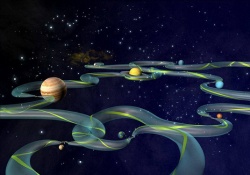Difference between revisions of "The First Bardo"
m (Text replacement - "second stage" to "second stage") |
|||
| Line 2: | Line 2: | ||
The first [[bardo]] comes at the very moment of [[death]], when there dawns the [[Clear Light]] of the [[Ultimate Reality]]. This is the very content and [[substance]] of the state of [[liberation]], if only the [[soul]] can [[recognize]] it and act in a way to remain in that state. The instructions intended to be read at the moment of the person's [[death]] are designed to help him do this. He is told, first of all, to embrace this supreme [[experience]] not in a [[selfish]] and [[egoistic]] way but rather with [[love]] and [[compassion]] for all [[sentient beings]]. This will aid him in the second step, which is to realize that his own [[mind]] and [[self]] is [[identical]] with the [[Clear Light]], implying that he himself IS the [[Ultimate Reality]], "the All-good [[Buddha]]", transcending [[time]], {{Wiki|eternity}}, and all creation. If he can [[recognize]] this while in this supreme state at the moment of [[death]], he will attain [[liberation]] - that is, he will remain in the [[Clear Light]] forever. This [[condition]] is called the "[[Dharmakaya]]", the [[highest]] [[spiritual]] [[body]] of the [[Buddha]]. | The first [[bardo]] comes at the very moment of [[death]], when there dawns the [[Clear Light]] of the [[Ultimate Reality]]. This is the very content and [[substance]] of the state of [[liberation]], if only the [[soul]] can [[recognize]] it and act in a way to remain in that state. The instructions intended to be read at the moment of the person's [[death]] are designed to help him do this. He is told, first of all, to embrace this supreme [[experience]] not in a [[selfish]] and [[egoistic]] way but rather with [[love]] and [[compassion]] for all [[sentient beings]]. This will aid him in the second step, which is to realize that his own [[mind]] and [[self]] is [[identical]] with the [[Clear Light]], implying that he himself IS the [[Ultimate Reality]], "the All-good [[Buddha]]", transcending [[time]], {{Wiki|eternity}}, and all creation. If he can [[recognize]] this while in this supreme state at the moment of [[death]], he will attain [[liberation]] - that is, he will remain in the [[Clear Light]] forever. This [[condition]] is called the "[[Dharmakaya]]", the [[highest]] [[spiritual]] [[body]] of the [[Buddha]]. | ||
| − | Most [[souls]], however, will fail to do this. They will be pulled down by the weight of their [[karma]] into the | + | Most [[souls]], however, will fail to do this. They will be pulled down by the weight of their [[karma]] into the second stage of the first [[bardo]], called the [[Secondary Clear Light]] seen immediately after [[death]]. At this point, there are separate instructions to be read according to the [[spiritual]] [[condition]] of the [[person]] while in [[life]]. For an {{Wiki|individual}} advanced in [[meditation]] and other [[spiritual]] practices, there is repeated over and over the same instructions as at the moment of [[death]], enjoining him to [[recognize]] himself as the [[Dharmakaya]]. For a [[person]] who was still at a student-level on the [[spiritual path]], there is the injunction for him to [[meditate]] on his "[[Wikipedia:tutelary deity|tutelary deity]]", that is, the particular [[god]] for whom he performed devotional practices while alive. Finally, "if the deceased be of the common {{Wiki|folk}}", unpracticed in any [[spiritual]] [[disciplines]], the instruction is to "[[meditate]] upon the Great [[Compassionate]] [[Lord]]", which is to say an "[[Avatar]]" worshipped by the multitude, {{Wiki|equivalent}} to {{Wiki|Jesus}} as conceived by the average {{Wiki|Christian}}. |
{{R}} | {{R}} | ||
[http://sgforums.com/forums/1728/topics/321931 sgforums.com] | [http://sgforums.com/forums/1728/topics/321931 sgforums.com] | ||
[[Category:Bardo]] | [[Category:Bardo]] | ||
Latest revision as of 14:08, 30 December 2014
The first bardo comes at the very moment of death, when there dawns the Clear Light of the Ultimate Reality. This is the very content and substance of the state of liberation, if only the soul can recognize it and act in a way to remain in that state. The instructions intended to be read at the moment of the person's death are designed to help him do this. He is told, first of all, to embrace this supreme experience not in a selfish and egoistic way but rather with love and compassion for all sentient beings. This will aid him in the second step, which is to realize that his own mind and self is identical with the Clear Light, implying that he himself IS the Ultimate Reality, "the All-good Buddha", transcending time, eternity, and all creation. If he can recognize this while in this supreme state at the moment of death, he will attain liberation - that is, he will remain in the Clear Light forever. This condition is called the "Dharmakaya", the highest spiritual body of the Buddha.
Most souls, however, will fail to do this. They will be pulled down by the weight of their karma into the second stage of the first bardo, called the Secondary Clear Light seen immediately after death. At this point, there are separate instructions to be read according to the spiritual condition of the person while in life. For an individual advanced in meditation and other spiritual practices, there is repeated over and over the same instructions as at the moment of death, enjoining him to recognize himself as the Dharmakaya. For a person who was still at a student-level on the spiritual path, there is the injunction for him to meditate on his "tutelary deity", that is, the particular god for whom he performed devotional practices while alive. Finally, "if the deceased be of the common folk", unpracticed in any spiritual disciplines, the instruction is to "meditate upon the Great Compassionate Lord", which is to say an "Avatar" worshipped by the multitude, equivalent to Jesus as conceived by the average Christian.
